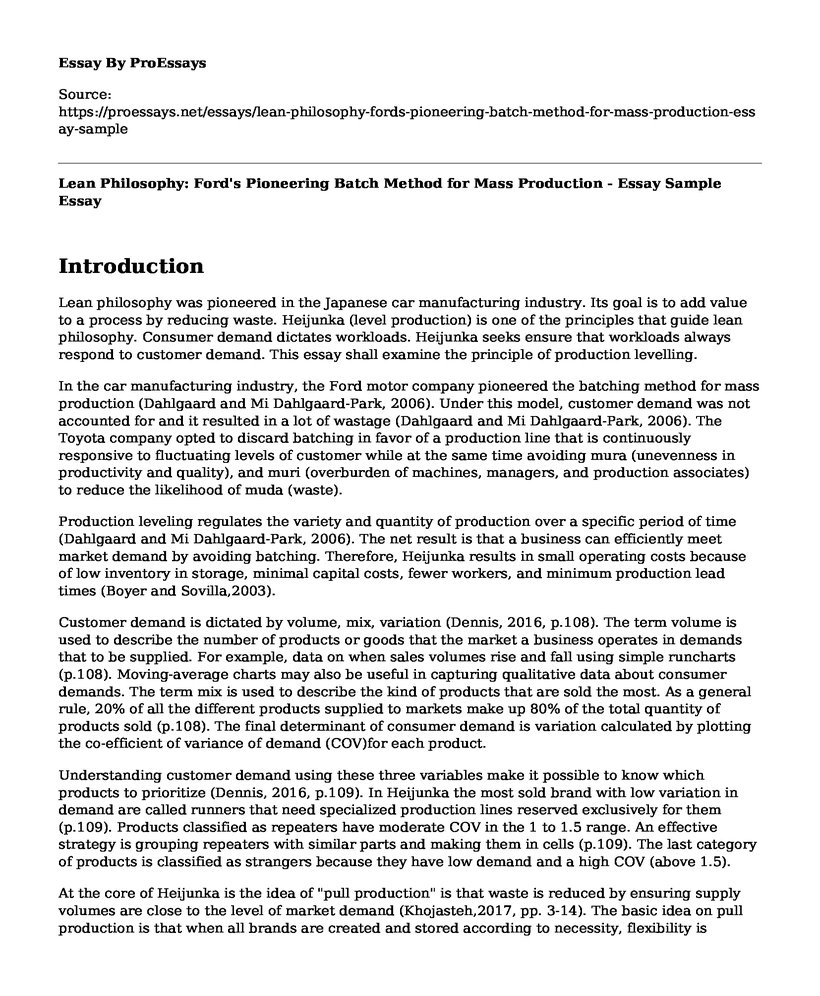Introduction
Lean philosophy was pioneered in the Japanese car manufacturing industry. Its goal is to add value to a process by reducing waste. Heijunka (level production) is one of the principles that guide lean philosophy. Consumer demand dictates workloads. Heijunka seeks ensure that workloads always respond to customer demand. This essay shall examine the principle of production levelling.
In the car manufacturing industry, the Ford motor company pioneered the batching method for mass production (Dahlgaard and Mi Dahlgaard-Park, 2006). Under this model, customer demand was not accounted for and it resulted in a lot of wastage (Dahlgaard and Mi Dahlgaard-Park, 2006). The Toyota company opted to discard batching in favor of a production line that is continuously responsive to fluctuating levels of customer while at the same time avoiding mura (unevenness in productivity and quality), and muri (overburden of machines, managers, and production associates) to reduce the likelihood of muda (waste).
Production leveling regulates the variety and quantity of production over a specific period of time (Dahlgaard and Mi Dahlgaard-Park, 2006). The net result is that a business can efficiently meet market demand by avoiding batching. Therefore, Heijunka results in small operating costs because of low inventory in storage, minimal capital costs, fewer workers, and minimum production lead times (Boyer and Sovilla,2003).
Customer demand is dictated by volume, mix, variation (Dennis, 2016, p.108). The term volume is used to describe the number of products or goods that the market a business operates in demands that to be supplied. For example, data on when sales volumes rise and fall using simple runcharts (p.108). Moving-average charts may also be useful in capturing qualitative data about consumer demands. The term mix is used to describe the kind of products that are sold the most. As a general rule, 20% of all the different products supplied to markets make up 80% of the total quantity of products sold (p.108). The final determinant of consumer demand is variation calculated by plotting the co-efficient of variance of demand (COV)for each product.
Understanding customer demand using these three variables make it possible to know which products to prioritize (Dennis, 2016, p.109). In Heijunka the most sold brand with low variation in demand are called runners that need specialized production lines reserved exclusively for them (p.109). Products classified as repeaters have moderate COV in the 1 to 1.5 range. An effective strategy is grouping repeaters with similar parts and making them in cells (p.109). The last category of products is classified as strangers because they have low demand and a high COV (above 1.5).
At the core of Heijunka is the idea of "pull production" is that waste is reduced by ensuring supply volumes are close to the level of market demand (Khojasteh,2017, pp. 3-14). The basic idea on pull production is that when all brands are created and stored according to necessity, flexibility is increased and production will satisfy peak demand periods. The most common type of pull system is Type A in which finished goods stores are situated at the end of the production line (Dennis, 2016, p.112).The size of the finished goods store is determined by the volume of production and withdrawal by customers. It works best when customer orders are frequent and production lead times are both short as well as stable (e.g. auto-part products). The second pull system is Type B for products with low demand and long customer lead times(p.112). The final pull system is Type C that is a mix of Type A and B(p.113). Under the Type C pull system, runners are put through the A system and while product classified as strangers are placed in the B system (p.113).
References
Boyer, M., & Sovilla, L. (2003). How to identify and remove the barriers for a successful lean implementation. Journal of Ship Production, 19(2), 116-120.
Dahlgaard, J. J., & Mi Dahlgaard-Park, S. (2006). Lean production, six sigma quality, TQM and company culture. The TQM magazine, 18(3), 263-281.
Dennis, P. (2016). Lean Production simplified: A plain-language guide to the world's most powerful production system. Crc press.
Khojasteh, Y. (2017). Pull Production Control Systems: Selection and Implementation Issues. In Production Management (pp. 3-14). Productivity Press.
Cite this page
Lean Philosophy: Ford's Pioneering Batch Method for Mass Production - Essay Sample. (2023, May 06). Retrieved from https://proessays.net/essays/lean-philosophy-fords-pioneering-batch-method-for-mass-production-essay-sample
If you are the original author of this essay and no longer wish to have it published on the ProEssays website, please click below to request its removal:
- An Intercultural Nursing Perspective Case Study
- Article Review on Amazon's New Microwave: 'Alexa, Please Defrost My Chicken'
- Starbucks Restaurants Evaluation Paper Example
- Impact of Conflict and Negotiation on the Organisational Culture of HSBC - Essay Sample
- Trinity Community Hospital's Risk Assessment Paper Example
- Research Paper Example on Organizational Structure: Key to Achieving Competitive Advantage
- Free Report Sample on Tropical Orchid Hotel: Alleged Food Contamination Crisis







